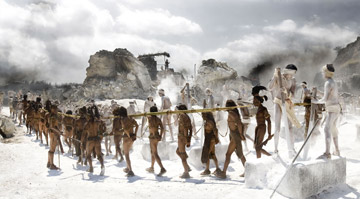

With Apocalypto, Mel Gibson reaffirms what everybody already knows - as a filmmaker, he uses a shocking amount of violence in order to convey his message across. This was evident in Braveheart, and even more so in The Passion of the Christ. The violence level is high again in Apocalypto, released just on the heels of some distractions in his personal life. Like Passion, Apocalypto was filmed in a language alien to most people (Aramaic there, Mayan here). Unlike Passion, there is not a built in audience ready to love the film regardless of its merits (or mistake the sheer violence for something else).
The setting of Apocalypto is the dying days of the Mayan empire. Jaguar Paw (Rudy Youngblood) lives in idyllic life in the forest. He hunts off the land that his ancestors lived off, and goes home to his wife Seven (Dalia Hernandez) and young son. Gibson uses the first part of Apocalypto to show Jaguar Paw and those around him as everybody people. They play jokes on each other, eat, laugh, and one has an annoying mother-in-law. This contrasts heavily with what shortly follows. Mayan warriors capture Jaguar Paw and the other villages, and destroy their village, killing many in the process. They tie them up, and force them to march to a huge stone city where many are sacrificed. Jaguar Paw has an inventive to escape - he hid Seven and his son in a small cavern.
The city is horrific to Jaguar Paw, who has never seen things like this. Stone monoliths hulk above the ground. Men wear gruesome masks, while paintings depict brutal beheadings. Slaves cough up blood while mining. The Mayan civilization is crumbling - crops are failing, and the only way they know to stave this is to sacrifice to their gods. It's Gibson's portrayal of the empire, struggling to hold onto its power even as it fades away. The images are monstrous - as they should be. Gibson wants the audience to feel as scared and disgusted as Jaguar Paw does when he enters. He toes the line between using violence as a tool, and becoming gratuitous, as when the priest pulls a heart out of a body.
Jaguar Paw escapes, and this is where Apocalypto kicks into high gear. Using cramped, fluid shots, Gibson captures the desperate chase as Jaguar Paw tries to make it home while eluding his captors. It's a breathless sprint through the jungles of Mexico, and it's this kind of filmmaking that Gibson excels at. The pace and actions are quick, and the stakes are high. Gibson worked with a cast of mostly non-actors, which is fine because there actually are not too many lines of dialogue. And although he fudges with history a bit (and detractors are sure to point out that none of the highlights of Mayan civilization are included), the visuals are gorgeous, and it's better to have people that look the part rather than actors that do not look Mayan. Apocalypto is a bit too long for its own good, but the parts that work really work.